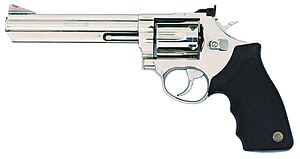February 7, 2014: Difference between revisions
mNo edit summary |
mNo edit summary |
(No difference)
| |
Latest revision as of 08:57, 21 January 2020
The Message of Guns
On Wednesday, we discussed excerpts of Marshall McLuhan’s Understanding Media—specifically the first and most famous chapter “The Medium Is the Message.” I’ve discussed McLuhan before, but to clarify McLuhan’s main point, I tried some examples—one from McLuhan himself.
McLuhan uses firearms as an example to undermine the wrong-headed and conventional position of “Firearms are in themselves neither good nor bad; it is the way they are used that determines their value.” McLuhan insists that this attitude is the “voice of the current somnambulism” and misses the point about the message—the “change in scale or pace or pattern” that a medium or technology introduces into human affairs—of guns. In other words: the tenor of the debate around guns blinds us to the real message of guns in this country.
The second amendment of the 1791 Bill of Rights reads:
| “ | A well regulated militia being necessary to the security of a free state, the right of the people to keep and bear arms shall not be infringed. | ” |
I’m not a constitutional scholar, but I can read. The key to interpreting this amendment is to contextualize it. What were the concerns of a new republic in 1791? “A well regulated militia” speaks to the necessity of keeping an organized, disciplined, and trained military force in order to defend a newly freed country. Having just come through the revolutionary war in 1783, this clause makes sense and continues, it seems, to make sense today as the US has the largest military in the world by far.
The second clause seems to be the anachronistic one and is obviously subordinate to the first. Again, this makes sense: if the militia is too small to defend against a foreign invader, the “people”—individual citizens not a part of the militia—will be needed to support the “well regulated militia.” Therefore, it seems prudent in 1791 that individual citizens should not only have the “right” to bear arms, but should be compelled—or at least strongly encouraged—to do so by this amendment. The security of the country could be at stake, after all. Remember those redcoats?
So the message here is to arm yourself for any chance of possible invasion. While this analysis of the second amendment is moot and has certainly been interpreted differently over the last 200 years, my conclusion seems nevertheless obvious. Invaders today could come from anywhere. Best to keep guns everywhere.
Elsewhere, I argue that the second amendment trumps the first amendment:
| “ | Yes, I have a right as a tenured professor and a citizen of the US to say what I want, but those ideological freedoms cannot stand up to the physical reality of a gun in my classroom. | ” |
Now we’re getting to the real message of the gun: you better behave yourself, or you could get shot. Just ask Chad Oulson or Trayvon Martin. The message of the gun (a medium or technology that changes the scale or pace or pattern of human affairs) is one of the threat of violence. It has nothing to do with how the gun is or is not used, but the sheer presence of the gun in American culture.
Do we in America want to live under the constant threat of violence that a culture of guns imposes? This is not necessarily a moral question, but a critical one. Are we so frightened by disagreement, difference of opinion, color of skin, that we erroneously assure ourselves we might keep it at bay if we pack heat?
We might consider one other aspect of the second amendment. Antonin Scalia suggests that “militia” would be a subset of the “people”: “male, able bodied, and within a certain age range.” This suggests an exclusivity toward the privileged male—one that he has enjoyed for centuries. This makes us wonder who, then, are “the people”? Are they the same as “We the People” of the US Constitution? Just who would they be in late eighteenth century? Male, white, landowning, slave owning, heterosexual … ?
Suppose Trayvon Martin had had a gun? Would the second amendment have applied?
